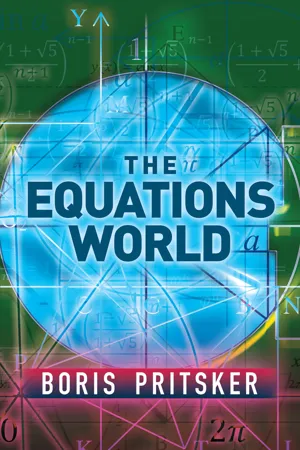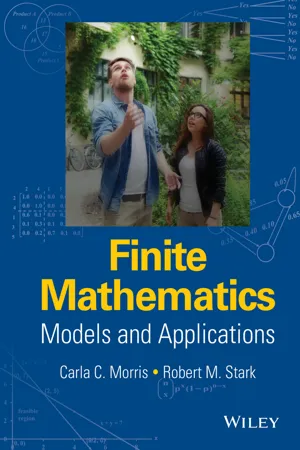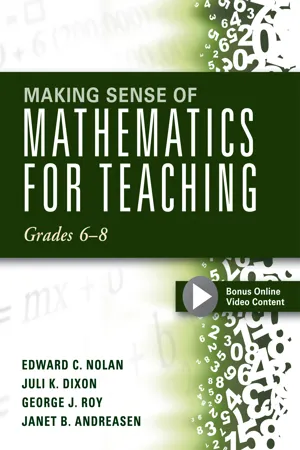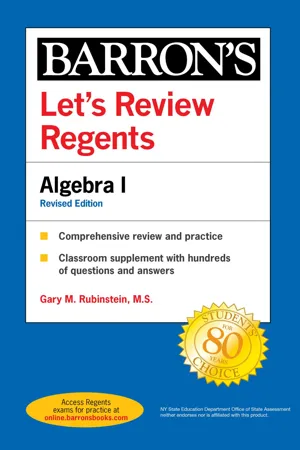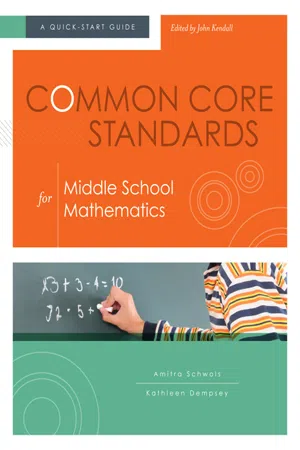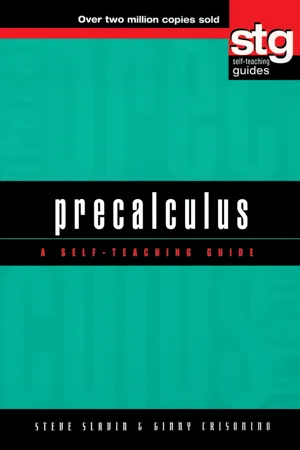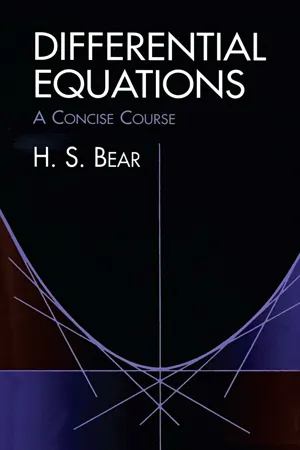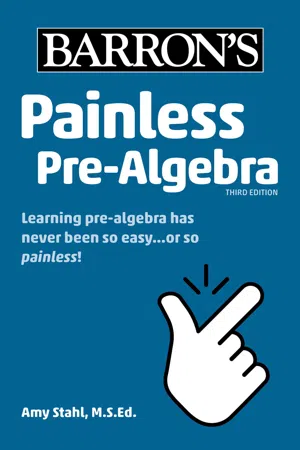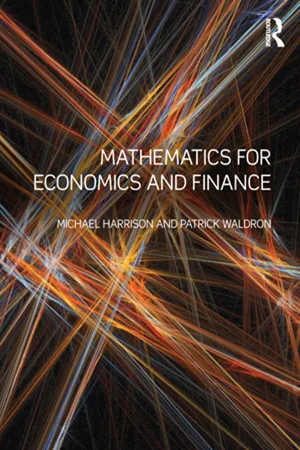Mathematics
Writing Linear Equations
Writing linear equations involves expressing a relationship between two variables using the form y = mx + b, where m represents the slope and b represents the y-intercept. This process allows for the creation of equations that can be graphed as straight lines, making it easier to analyze and interpret the relationship between the variables.
Written by Perlego with AI-assistance
Related key terms
12 Key excerpts on "Writing Linear Equations"
- eBook - ePub
- Boris Pritsker(Author)
- 2019(Publication Date)
- Dover Publications(Publisher)
Chapter 1 Linear EquationsAn equation is a statement that claims that two quantities are equal. In mathematics the term “equation” means equality with one or more variables or unknowns. “Variable” comes from the Latin translation “capable of changing.” Our ancestors in ancient Babylonia and Egypt stated and solved problems using equations, but not in the same way it is done today. They did not identify any formulas or algorithms for solving equations, but everything was “solved” in verbal descriptions and instructions. Representing known and unknown quantities by letters (variables) was first done by the French attorney François Viète (1540–1603). It was his brilliant idea to work with letters as if they are numbers and obtain the result in which the numbers are substituted at the very end to get the answer. Though not a professional mathematician by education, Viète made quite remarkable contributions to the field of mathematics. He was the first to introduce notations for problem solutions and to formalize mathematics, which allowed for a simplification of algebraic manipulations. Without his accomplishments, it would not be possible to work easily with equations. His approach to use the “variable” as a supplemental tool for solving different problems was a huge step forward in the development of contemporary algebra. He created a new language that allows us to express ideas, logic, and problems in an organized and systematic way.Viète suggested three stages in solving a problem: First, summarize the problem in the form of an equation. Denote the known quantities by constants-consonants (Viète was the first to use the term coefficients to define the numbers in an equation) and unknown by variables-vowels. In 1637 the great French mathematician and philosopher René Descartes (1596–1650) suggested using x , y , z (the last letters in the alphabet) as variables and a , b , c - eBook - ePub
Making Sense of Mathematics for Teaching High School
Understanding How to Use Functions
- Edward C. Nolan, Juli K. Dixon, Farhsid Safi, Erhan Selcuk Haciomeroglu(Authors)
- 2016(Publication Date)
- Solution Tree Press(Publisher)
x-coordinate (or time). As they construct and solve linear equations, students describe and explain what a solution represents in multiple representations. As they explore the relationship between distance and time, they create a table of values and plot points on the Cartesian coordinate plane. Students learn that every point on the graph of the line represents a solution for this equation, and a visual representation of the solution for this linear equation creates a straight line. When presented with a system of two linear equations, they understand that a possible solution is the point of intersection of their graphs because the point of intersection satisfies both equations simultaneously. In grade 8, students also extend their exploration of functions to define, evaluate, and compare linear and nonlinear functions using different representations.High SchoolIn high school, students extend the concepts related to linear functions to explore different forms of linear functions beyond the slope-intercept form of y = mx + b. As students gain experience with algebraic equations and their solutions in different representations, they come to understand the advantages of writing equations in various forms. Seeing structure in equations and exploring the benefits of each structure is an important component of working with functions in different forms as students understand and express functional relationships in multiple representations.Throughout high school, students extend their interaction with linear equations to include representing and solving systems of equations graphically. Following explorations from grade 8 when students analyzed and solved linear equations and solved systems of linear equations, high school students make sense of the solution of systems of linear equations and connect multiple representations of systems of equations to one another. In addition, they prove that the method of substitution or elimination produces a system with the same solutions. - eBook - ePub
Finite Mathematics
Models and Applications
- Carla C. Morris, Robert M. Stark(Authors)
- 2015(Publication Date)
- Wiley(Publisher)
It is a conditional equation since it is only true when. Equations that hold for all values of the variable are called identities. For example, is an identity. By solving an equation, values of the variables that satisfy the equation are determined. An equation in which only the first powers of variables appear is a linear equation. Every linear equation in a single variable can be solved using some or all of these properties: Substitution – Substituting one expression for an equivalent one does not alter the original equation. For example, is equivalent to or. Addition – Adding (or subtracting) a quantity to each side of an equation leaves it unchanged. For example, is equivalent to or. Multiplication – Multiplying (or dividing) each side of an equation by a nonzero quantity leaves it unchanged. For example, is equivalent to or. To Solve Single Variable Linear Equations 1. Resolve fractions. 2. Remove grouping symbols. 3. Use addition and/or subtraction to move variable terms to one side of the equation. 4. Divide the equation by the variable coefficient. 5. Verify the solution in the original equation as a check. Example 1.1.1 Solving a Linear Equation Solve. Solution: To remove fractions, multiply both sides of the equation by 6, the least common denominator of 2 and 3. The revised equation becomes Next, remove grouping symbols to yield Now, subtract 4x and add 48 to both sides to yield Finally, divide both sides by 5 (the coefficient of x) to attain. The result, is checked by substitution in the original equation: Equations often contain more than one variable. To solve linear equations in several variables simply bring the variable of interest to one side. Proceed as for a single variable, considering the other variables as constants for the moment. Example 1.1.2 Solving for y Solve for y :. Solution: Move terms with y to one side of the equation and any remaining terms to the opposite side. Here, - eBook - ePub
Linear Algebra
An Inquiry-Based Approach
- Jeff Suzuki(Author)
- 2021(Publication Date)
- CRC Press(Publisher)
2Systems of Linear Equations
In this chapter, we’ll consider the problem of solving systems of linear equations. This is a critical part of linear algebra, and we offer the following general strategy:Strategy. Every problem in linear algebra begins with a system of linear equations.2.1 Standard Form
When trying to work with a collection of objects, it’s easiest if they’re all in some standardized format. You’ve seen such standardized formats before: it’s convenient to rewrite a given quadratic equation in the forma; it’s convenient to write the equation of a line in the formx 2+ b x + c = 0y = m x + b; and so on. In this activity, we’ll develop a standard form for a system of linear equations.Activity 2.1: Standard Form We’ll say that an equation has been reduced to simplest form if it has as few terms as possible.A2.1.1 The equation3 x − 5 y = 8has three terms: 3x, 5y, and 8. If possible, rewrite the equation so it has fewer terms; if not possible, explain why not.A2.1.2 The equation2 x + 7 z = 1 + 2 y + 5 xhas five terms. If possible, rewrite the equation so it has fewer terms; if not possible, explain why not.A2.1.3 The equation5 x − 2 y + z + 12 = 0has five terms. If possible, rewrite the equation so it has fewer terms; if not possible, explain why not.Activity 2.1 motivates the following definition:Definition 2.1 (Standard Form). A linear equation is in standard form when- All of the variables are on one side of the =,
- The constant is on the other side of the =.
As Activity 2.1 shows, equations in standard form will have fewer terms than equations not in standard form.In Activity A1.3.2, we represented linear equations as vectors. If we have a system of equations, we can represent the entire system as a collection of vectors and, as long as all - eBook - ePub
Making Sense of Mathematics for Teaching Grades 6-8
(Unifying Topics for an Understanding of Functions, Statistics, and Probability)
- Edward C. Nolan, Juli K. Dixon(Authors)
- 2016(Publication Date)
- Solution Tree Press(Publisher)
Much of the focus of the content of expressions, equations, and inequalities in the middle grades provides the groundwork for understanding algebra. As students make sense of real-world situations with unknown quantities that do and do not vary, they engage in algebraic reasoning. Students learn to write and solve expressions, equations, and inequalities, using context to help make sense of the language and structure of mathematics. Students in grades 6–8 must be able to write expressions and equations from context, solve equations and inequalities, investigate the concept of slope, and solve systems of equations.Writing Expressions and Equations From Context
In language, an expression communicates an idea. The same can be said for algebraic expressions—they communicate what contexts represent. Interpreting context lays a foundation for making sense of algebra. Consider the task provided in figure 3.7 .Figure 3.7: The pencils and highlighters task.You are cleaning out your desk at school. You find that you have 6 times as many pencils as highlighters. Write an equation for the number of pencils (p ) in terms of the number of highlighters (h ).How did you set up your equation? When posed with this task, many people write the equation 6p = h . How can you test this equation to see if it matches the context? When you start to substitute numbers for the variables in the equation 6p = h , what do you notice? If you let p equal 12, then h is 72. Does this make sense in the context of the problem? Returning to the context, you realize that there should be more pencils than highlighters, in fact, six times more. Instead of thinking about the relationship between the number of pencils and the number of highlighters, the equation 6p = h was written to follow the order of the items presented in the task; whereas, the equation 6h = p correctly represents the mathematical relationship. This is an important example of the need to combine the language of mathematics—and possibly the use of the key words - eBook - ePub
- Gary M. Rubinstein(Author)
- 2021(Publication Date)
- Barrons Educational Services(Publisher)
y when the other variable’s value is known.Graphing the Solution Set of a Linear Equation That Is in Slope-Intercept Form
Math Facts
An equation like y = 2x + 3 or is said to be inslope-intercept form. In general, an equation of the form y = mx + b is in slope-intercept form with the m representing the slope and the b representing the y-intercept.To graph the solution set of a linear equation that is already in slope–intercept form:- Plot the point (0, b), which is on the y-axis. If the equation is y = 2x + 3, plot the point (0, 3). This is known as the y-intercept of the graph.
- If the coefficient of the x term is not already a fraction, turn it into a fraction by putting the coefficient in the numerator of a fraction and a 1 in the denominator. If the coefficient is a negative fraction, make the numerator negative and the denominator positive. For the example, y = 2x + 3, the slope, denoted by m, is 2, which gets changed into .
- Starting at the y-intercept you already plotted, move right the number in the denominator of the slope. Then, from where you stopped, move up (down if it is negative) the number in the numerator of the slope. For the y = 2x + 3 example, the slope is
so from (0, 3), you move to the right 1 unit and then up 2 units to get to the point (1, 5).
- Draw a line through the y-intercept and the new point. Put arrows on both sides of the line to indicate that it continues forever on both sides.
Example 1
Make a sketch of the solution set of the graph using the slope-intercept process.Solution: Since the constant is 5, the y-intercept is (0, 5). Since the coefficient of the x term is , - eBook - ePub
Common Core Standards for Middle School Mathematics
A Quick-Start Guide
- Amitra Schwols, Kathleen Dempsey, John Kendall, John Kendall(Authors)
- 2013(Publication Date)
- ASCD(Publisher)
b. Solve linear equations with rational number coefficients, including equations whose solutions require expanding expressions using the distributive property and collecting like terms. 8. Analyze and solve pairs of simultaneous linear equations.a. Understand that solutions to a system of two linear equations in two variables correspond to points of intersection of their graphs, because points of intersection satisfy both equations simultaneously.b. Solve systems of two linear equations in two variables algebraically, and estimate solutions by graphing the equations. Solve simple cases by inspection. For example, 3x + 2y = 5 and 3x + 2y = 6 have no solution because 3x + 2y cannot simultaneously be 5 and 6.c. Solve real-world and mathematical problems leading to two linear equations in two variables. For example, given coordinates for two pairs of points, determine whether the line through the first pair of points intersects the line through the second pair.Many of the skills associated with the ability to create equations and use them to solve problems are required by standards outside the Equations and Expressions domain. Students will certainly need these skills to successfully build and reason with functions, the topic addressed in the next chapter. - eBook - ePub
Precalculus
A Self-Teaching Guide
- Steve Slavin, Ginny Crisonino(Authors)
- 2001(Publication Date)
- Trade Paper Press(Publisher)
m = −2. We can use the first formula:2. First let’s start by finding the slopeWe don’t know the y-intercept, so we have to use the second formula:3. We don’t know the y-intercept, so we’ll use the second formula:4. The points we’re given are (6,0) and (0,−3). We need to find the slope.5. We know this is a horizontal line because both points have the same y value. We also know that the equation of any horizontal line is y = a constant, y = 1 is the equation of this horizontal line.6. We know this is a vertical line because both points have the same x value. We also know that the equation of any vertical line is x = a constant, x = 5 is the equation of this vertical line.4 Graphs of Linear FunctionsA linear equation is a polynomial equation whose highest exponent is 1. It’s also called a first-degree equation. The graph of a linear equation is always a straight line. We need only two points to graph a straight line. The points we want to see on your graphs are the intercepts. You’ll find graphing linear equations to be very simple, especially since we reviewed how to find intercepts in section 1 of this chapter.Example 10:Graph 2x + 4y = 8.Solution:We’ll start by finding the x and the y intercepts; then we’ll plot the points and connect them with a straight line. Be sure to extend the line beyond those points and put arrows at the ends of the lines to show that the graph doesn’t end at these points. If you don’t put arrows at the end, it’s a line segment, which is only part of the graph. Write the equation of the line on your graph and label the intercepts.Example 11:Graph −2x + 4y = 8.Solution:Notice that this equation is almost identical to the equation in example 10. The only difference is the negative in front of the 2x. Let’s see what kind of an effect this has on our graph.The negative in front of the 2x reverses the line’s direction. When we write the equation −2x + 4y = 8 in y = mx + b form, it’s . Now it’s rising instead of falling. The slope of the line in example 9 is positive and its y-intercept is 2. When we write the equation 2x + 4y = 8 in y = mx + b form it’s . The slope of the line in example 8 is negative and its y - eBook - ePub
Differential Equations
A Concise Course
- H. S. Bear(Author)
- 2013(Publication Date)
- Dover Publications(Publisher)
CHAPTER 3LINEAR EQUATIONS3-1 Introduction. A linear equation is one of the formWe will always assume that p0, p1, . . . , q are all defined and continuous on some interval (a, b). If the right-hand member, q, in (1 ) is zero, we say (1 ) is a homogeneous linear equation. The following are some examples of linear equations:The class of linear equations is large enough to encompass a great many of the most useful and frequently encountered differential equations. At the same time, the linear equation is sufficiently specialized to admit a very comprehensive and elegant theory. We will develop this theory in detail and see that it provides simple methods of solving a large class of of linear equations. Our principal tool will be the basic existence and uniqueness theorem for linear equations. As we indicated in Section 1-4 , there is a general existence and uniqueness theorem for nth order equations of the formHowever, Eq. (1 ) is much more restrictive than (2 ), and we should expect a better theorem for linear equations because of the stronger hypotheses inherent in the form of (1 ). Here is the theorem (to be proved in Chapter 7 ) for linear equations.THEOREM 1. If p0, p1, . . . , pn−1 , q are continuous on (a, b), and x0 is any number in the interval (a, b), and y0 , are any numbers, then there is a unique function y which is a solution of (1 ) on all of (a, b) such thatThe thing to note about this theorem is that it guarantees the existence of a solution on the whole interval on which the coefficient functions are continuous. Moreover, the uniqueness of the solution is an automatic consequence of the form of the equation (compare with the examples of Section 1-3 - eBook - ePub
Differentiating Instruction in Algebra 1
Ready-to-Use Activities for All Students (Grades 7-10)
- Kelli Jurek(Author)
- 2021(Publication Date)
- Routledge(Publisher)
y-intercept. Their finished puzzle is the message "Math Does Rock Says Me 2 U" (with the help of some text messaging shortcuts).- ➤ Students may notice that there are puzzle pieces that are blank on one side. They may figure out that these pieces belong on the outer edge of the puzzle.
Discussion Questions (To be asked after the lesson.)- ➤ What message is revealed when the puzzle is completed?
- ➤ How do you determine whether an ordered pair is a solution to an equation? How many solutions are there to a linear equation?
- ➤ Can all equations be rewritten in the form of y =? Why would we want to write equations in this form?
- ➤ How do you determine the slope and the y-intercept from an equation?
Lesson 1: IntRoduction
Student Coordinate Grid Whole-Class Activity Lesson Plan
Purpose: Students will model a system of linear equations by using the classroom as a coordinate grid.Prerequisite Knowledge Materials Needed Students should know how to:• solve equations,• check solutions to equations,• graph equations on calculators, and• find coordinates on a coordinate grid. • One copy of the student worksheet for each student• Note cards with coordinate pairs (0, 0) through (5, 4)• Overhead projector with 6x5 grid matching the setup of the desks Discussion Questions (To be asked before the lesson.)- ➤ Can two different linear equations have one solution in common?
- ➤ What does this solution mean?
Lesson
- ➤ Write the following equations on the board, and label them for future reference. Equation A x + y= 5Equation B x- y= -1
- ➤ Arrange the classroom desks into a coordinate grid. Each student will represent one of the ordered pairs. Below is an example of a class with 30 students. This activity could also be done outside with a grid drawn with sidewalk chalk.
- eBook - ePub
- Amy Stahl(Author)
- 2021(Publication Date)
- Barrons Educational Services(Publisher)
y-intercept of −2.Solution:Remember that the coordinates of the x-intercept would be (7, 0). You have a point and a slope given to you, so you can write the equation of the line.y = mx + b0 = −3(7) + b0 = −21 + bb = 21The equation of the line would be y = −3x + 21.For a line to be parallel to this line, the slopes have to be the same. So, the slope = −3, and the new y-intercept = −2. The new equation would be y = −3x − 2.Example 2:The math department sponsors a Family Fun Night each year. In the first year, there were 70 participants. In the third year, there were 114 participants. a.Write an equation to represent this situation. b.If this trend continues, how many participants can be expected in the sixth year? Solution: a.This problem is really giving you two coordinates. The 70 participants in the first year are represented by (1, 70), and the 114 participants in the third year, (3, 114). Use these points (1, 70) and (3, 114) to write the equations. Solution:Equation is y = 22x + 48b.Use the equation to make the prediction for year 6 (when x = 6).y = 22x + 48y = 22(6) + 48y = 132 + 48y = 180If the pattern continues, they can expect 180 people for year 6.Example 3:All tickets for a country concert are the same price, and the ticket company charges a one-time user fee. A person who orders 5 tickets pays $385. A person who orders 3 tickets pays $235. a.Write an equation relating the total cost to the number of tickets purchased. b.If you spent $910, how many tickets did you buy? Solution:a.Again, the problem is really giving you two points (5, 385) and (3, 235). Use these two points to write the equation of the line. This time the solution will show how to do this using the y = mx + b - eBook - ePub
- Michael Harrison, Patrick Waldron(Authors)
- 2011(Publication Date)
- Routledge(Publisher)
Systems of linear equations and matrices
DOI: 10.4324/9780203829998-31.1 Introduction
This chapter focuses on matrices. It begins by discussing linear relationships and systems of linear equations, and then introduces the matrix concept as a tool for helping to handle and analyse such systems. Several examples of how matrices might arise in specific economic applications are given to motivate the mathematical detail that follows. These examples will be used again and further developed later in the book. The mathematical material that follows the examples comprises discussions of matrix operations, the rules of matrix algebra, and a taxonomy of special types of matrix encountered in economic and financial applications.1.2 Linear equations and examples
Linear algebra is a body of mathematics that helps us to handle, analyse and solve systems of linear relationships. A great deal of economics and finance makes use of such linear relationships. A linear relationship may be represented by an equation of the formwhere x, y and z are variables and α and ß are constants. Such relationships have several nice properties. One is that they are homogeneous of degree one, or linearly homogeneous, i.e. if all variables on the right-hand side are scaled (multiplied) by a constant, θ, then the left-hand side is scaled in the same way. Specifically, using (1.1 ), we havez = α x + β y1.1z * = α1.2(+ βθ x)(= θθ y)(= θ zα x + β y)Another property of linear relationships is that, for different sets of values for their variables, they are additive and their sum is also linear. Suppose we have the two equations z1 = αx1 + ßy1 and z2 = αx2 + ßy2 , then1.3 after slight rearrangement, which may be written asz 1+z 2= α(+ β)x 1+x 2()y 1+y 2Z = α X + β Y1.4 where X = x1 + x2 , Y = y1 + y2 and Z = z1 + z2 . The result, equation (1.4) , is a linear equation in the sums of the respective variables. The generalization to the case of n equations is straightforward and hasX =., Y∑i = 1nx iand Z =∑i = 1ny i∑i = 1nz iThese simple properties constitute one reason why linear relationships are so widely used in economics and finance, and particularly when relationships, such as demand and supply curves, are first introduced to students.1
Index pages curate the most relevant extracts from our library of academic textbooks. They’ve been created using an in-house natural language model (NLM), each adding context and meaning to key research topics.
